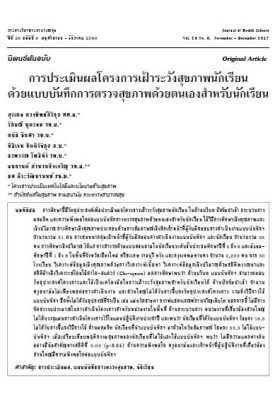This website uses cookies so that we can provide you with the best user experience possible. Cookie information is stored in your browser and performs functions such as recognising you when you return to our website and helping our team to understand which sections of the website you find most interesting and useful.
การประเมินผลโครงการเฝ้าระวังสุขภาพนักเรียนด้วยแบบบันทึกการตรวจสุขภาพด้วยตนเองสำหรับนักเรียน

รายละเอียดเพิ่มเติม
สุรเดช ดวงทิพย์สิริกุล
รักมณี บุตรชน
ดนัย ชินคำ
นิธิเจน กิตติรัชกุล
อรพรรณ โพธิหัง
ชนกานต์ ด่านวนกิจเจริญ
ยศ ตีระวัฒนานนท์
บทคัดย่อ:
การศึกษานี้มีวัตถุประสงค์เพื่อประเมินผลโครงการเฝ้าระวังสุขภาพนักเรียน ในด้านบริบท ปัจจัยนำเข้า กระบวนการ ผลผลิต และความพึงพอใจต่อแบบบันทึกการตรวจสุขภาพด้วยตนเองสำหรับนักเรียน ใช้วิธีการศึกษาเชิงคุณภาพและเชิงปริมาณ การศึกษาเชิงคุณภาพประกอบด้วยการสัมภาษณ์เชิงลึกเจ้าหน้าที่ผู้รับผิดชอบการดำเนินงานแบบบันทึกฯ จำนวนรวม 31 คน การสนทนากลุ่มเจ้าหน้าที่ผู้รับผิดชอบการดำเนินงานแบบบันทึกฯ และนักเรียน จำนวนรวม 25 คน การศึกษาเชิงปริมาณ ได้แก่ การสำรวจด้วยแบบสอบถามในนักเรียนระดับชั้นประถมศึกษาปีที่ 5 ถึง 6 และมัธยมศึกษาปีที่ 1 ถึง 6 ในพื้นที่จังหวัดเชียงใหม่ ศรีสะเกษ ราชบุรี ตรัง และกรุงเทพมหานคร จำนวน 2,200 คน จาก 50 โรงเรียน วิเคราะห์ข้อมูลเชิงคุณภาพด้วยการวิเคราะห์เนื้อหา วิเคราะห์ข้อมูลเชิงปริมาณด้วยสถิติพรรณนาและสถิติอ้างอิงวิเคราะห์โดยใช้ค่าไค-สแควร์ (Chi-square) ผลการศึกษาพบว่า ด้านบริบท แบบบันทึกฯ สามารถตอบวัตถุประสงค์โครงการและใช้เป็นเครื่องมือในการเฝ้าระวังสุขภาพสำหรับนักเรียนได้ ด้านปัจจัยนำเข้า จำนวนครูอนามัยไม่เพียงพอต่อการดำเนินงาน และส่วนใหญ่ไม่ได้รับการชี้แจงวัตถุประสงค์โครงการ รวมถึงวิธีการใช้แบบบันทึกฯ อีกทั้งไม่ได้รับอุปกรณ์ที่จำเป็น เช่น แผ่นวัดสายตา กราฟแสดงเกณฑ์การเจริญเติบโต นอกจากนี้ ไม่มีการจัดสรรงบประมาณในการดำเนินโครงการสำหรับหน่วยงานในพื้นที่ ด้านกระบวนการ หน่วยงานที่เกี่ยวข้องส่วนใหญ่ไม่ได้บรรจุแผนการดำเนินโครงการไว้ในแผนปฏิบัติงานประจำปี และพบว่า นักเรียนที่ได้รับแบบบันทึกฯ ร้อยละ 18.5 ไม่ได้รับการชี้แจงวิธีการใช้ ด้านผลผลิต นักเรียนที่นำแบบบันทึกฯ มาด้วยในวันสัมภาษณ์ ร้อยละ 55.3 ไม่ใช้แบบบันทึกฯ เมื่อเปรียบเทียบพฤติกรรมสุขภาพของนักเรียนที่ไม่ใช้และใช้แบบบันทึกฯ พบว่า ไม่มีความแตกต่างกันอย่างมีนัยสำคัญทางสถิติที่ 0.05 (p<0.05) ด้านความพึงพอใจ ครูอนามัยและเจ้าหน้าที่ผู้ปฏิบัติงานที่เกี่ยวข้องส่วนใหญ่มีความพึงพอใจต่อแบบบันทึกฯ
คำสำคัญ : การประเมินผล, แบบบันทึกการตรวจสุขภาพ, นักเรียน
Abstract:
This study aims to evaluate the Student Health Surveillance (SHS) Program of Department of Health, Ministry of Public Health (MOPH), using context, input, process, product, and satisfaction of stakeholders towards the Self-Health Assessment Form for Student (SHAF) in the evaluation framework. Both qualitative and quantitative methods were employed in the inquiry. Concerning qualitative approach, in-depth interview was conducted in thirty-three staff, including healthcare providers and teachers, who were responsible for SHAF management. Focus group discussion was performed with twenty-five participants namely, health providers, teachers, and students. For quantitative approach, a questionnaire survey was distributed to 2,200 students (grade 5 – 12) from 50 schools locating in Chiang Mai, Srisaket, Rachaburi, Trang and Bangkok provinces. Content analysis, descriptive statistics analysis, and Chi-square test were employed for data analyses. Results from context analysis indicated that the SHAF responded to the objectives of SHS program because it could be used to monitor student health. For input evaluation, the number of school health teachers was inadequate and most of them did not received information about the objectives of SHS program as well as how to use the form. The teachers did not receive the key tools such as eye charts for measurement of visual acuity and growth charts, etc. to perform student health checks. In addition, no budget was allocated to support the SHS program operation at local level. Regarding process evaluation, relevant agencies did not include SHS program into their annual action plans. Furthermore, eighteen point five percent of students who received the self-assessment form were not informed about the instruction of how to use it. Fifty-five-point three percent of students who brought SHAF with them on the interview date, had never used it. Health behaviors of those who use and not use the form were not different (p<0.05). Considering stakeholders’ satisfaction towards the form, health providers and teachers stated they were satisfied with the SHAF.
Keyword: Evaluation, Self-Health Assessment Form for Student, Student




